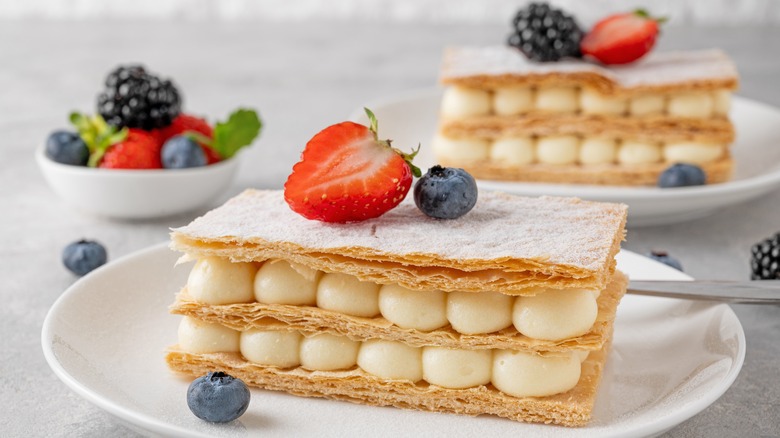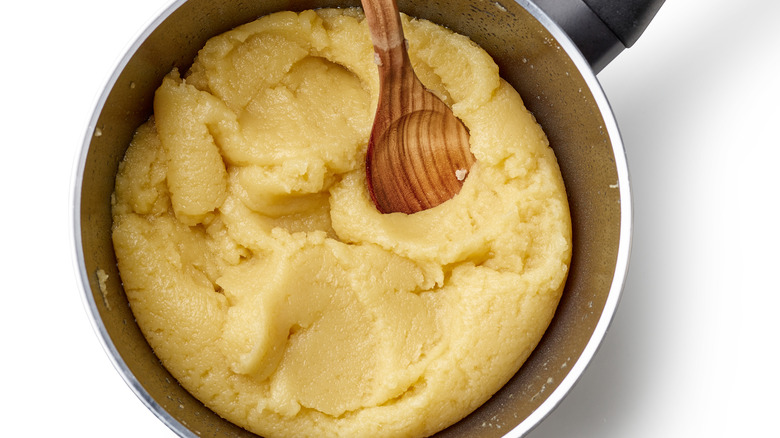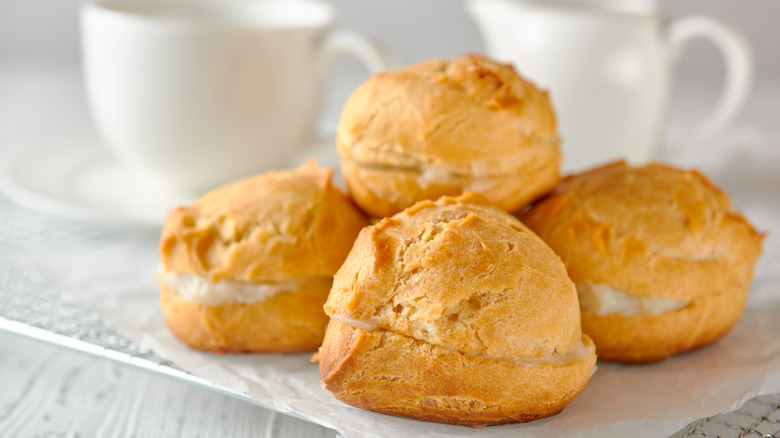The Layered Difference Between Choux And Puff Pastry
When peering through a French bakery's display window, you might spot a row of elegant, towering desserts featuring custards, creams, and chocolate glazes. Many of these classic desserts rely on two kinds of dough to give them their shape and texture: choux and puff pastry. Though both types of pastry have gained a reputation as some of the hardest recipes to make from scratch, understanding how they're made can teach you a lot about baking, even if you end up using a store-bought version in the end.
Mille-feuilles, palmiers, fruit turnovers, Danishes, and other flaky desserts usually employ puff pastry to achieve those delicate and crispy layers. To get its trademark airy lift, puff pastry relies on layers and layers of butter. Chefs use a kneading technique called lamination to fold the fat into flour, similar to the approach used to make croissants. In the hot oven, the super-thin layers of laminated butter evaporate and create steamy air pockets, puffing up the dough.
Éclairs and profiteroles, on the other hand, feature choux (pronounced "shoe") pastry. Like its puffy counterpart, the key to choux's height and texture is steam. The difference is this dough begins by cooking ingredients on the stove to add extra hydration. The result is a dessert that holds its airy shape even after cooling.
The difference is in the dough
Though both of these pastry doughs rely on steam to form airy layers, that's about all their recipes have in common. Choux pastry features a dough of water or milk and flour that's cooked briefly on the stove to activate and hydrate its starches, allowing it to rise better. Chefs also add egg to the mixture to give it structure and a glossy finish before it heads into the oven.
To transform the thick choux mixture into a light profiterole or éclair, bakers pipe dots or lines onto a baking sheet. In the oven, the shapes expand and form airy pockets. The result is a pastry that's light, tender, and slightly eggy, with plenty of space inside for a creamy filling to be piped in. The choux has to be completely cooled before bakers pipe in pastry cream, ganache, whipped cream or other fillings.
Puff pastry, on the other hand, relies on thin strips of butter painstakingly folded into a lean dough made of just water and flour. The resulting sheets of dough can be brushed with butter and baked as-is, or stuffed with a sweet or savory filling. After cooking, the delicate pastry's layers will turn flaky, browned, and crispy, similar to a croissant. For those of us who are intimidated by puff pastry, pre-prepared versions are available in many grocery stories, and even make it onto chef Ina Garten's list of approved store-bought ingredients. Just make sure you buy an all-butter variety.
How to use choux and puff pastry
While store-bought puff pastry is very easy to find, choux dough is not generally sold in stores. Although you can freeze raw choux before baking it, if you opt to make your own, the only pre-prepared choux typically sold in stores are pre-cooked éclairs and profiteroles, with or without filling. Store-bought hollow choux pastry allows you to add your own fillings for delicious semi-homemade treats.
One major commonality between puff and choux pastry is that they're both tasty blank canvases, up to the challenge of forming a savory appetizer or a showstopping dessert. Frozen sheets of puff dough can be used in everything from beef Wellington and samosas to apple turnovers and strudel. Home cooks trying their hand at choux pastry can add cheese to the dough to bake gougères, savory and cheesy pastry puffs in a cute bite-sized shape.
Because both doughs have a neutral flavor, they're also great to experiment with to create your own pastry recipes. Puff pastry bakes quickly, making it a particularly convenient vehicle for leftover fruits or vegetables baked in an open-face galette. Any jams or jellies you need to use up can be mixed with cream to make delicious stuffings for choux-based profiteroles, or you can even use bacon jam paired with a filling of sautéed mushrooms for a delicious savory version.



